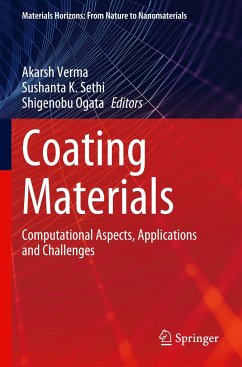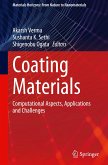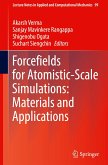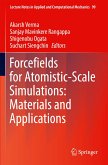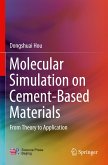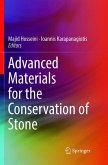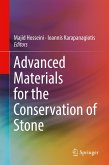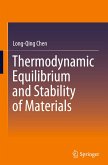Coating Materials
Computational Aspects, Applications and Challenges
Herausgegeben:Verma, Akarsh; Sethi, Sushanta K.; Ogata, Shigenobu
Coating Materials
Computational Aspects, Applications and Challenges
Herausgegeben:Verma, Akarsh; Sethi, Sushanta K.; Ogata, Shigenobu
- Broschiertes Buch
- Merkliste
- Auf die Merkliste
- Bewerten Bewerten
- Teilen
- Produkt teilen
- Produkterinnerung
- Produkterinnerung
This book comprehensively reviews assorted types of coatings, their applications, and various strategies employed by several scientists and researchers to fabricate them. Exclusively, the recent progress in computational strategies that are helpful to optimize the best suitable coating formulation before one goes for the real-time fabrication has been discussed in detail. And this book is also intended to shed light on the computational modeling techniques that are used in the characterization of various coating materials. It covers mechanisms, salient features, formulations, important…mehr
Andere Kunden interessierten sich auch für
![Coating Materials Coating Materials]() Coating Materials90,99 €
Coating Materials90,99 €![Forcefields for Atomistic-Scale Simulations: Materials and Applications Forcefields for Atomistic-Scale Simulations: Materials and Applications]() Forcefields for Atomistic-Scale Simulations: Materials and Applications134,99 €
Forcefields for Atomistic-Scale Simulations: Materials and Applications134,99 €![Forcefields for Atomistic-Scale Simulations: Materials and Applications Forcefields for Atomistic-Scale Simulations: Materials and Applications]() Forcefields for Atomistic-Scale Simulations: Materials and Applications134,99 €
Forcefields for Atomistic-Scale Simulations: Materials and Applications134,99 €![Molecular Simulation on Cement-Based Materials Molecular Simulation on Cement-Based Materials]() Dongshuai HouMolecular Simulation on Cement-Based Materials75,99 €
Dongshuai HouMolecular Simulation on Cement-Based Materials75,99 €![Advanced Materials for the Conservation of Stone Advanced Materials for the Conservation of Stone]() Advanced Materials for the Conservation of Stone86,99 €
Advanced Materials for the Conservation of Stone86,99 €![Advanced Materials for the Conservation of Stone Advanced Materials for the Conservation of Stone]() Advanced Materials for the Conservation of Stone119,99 €
Advanced Materials for the Conservation of Stone119,99 €![Thermodynamic Equilibrium and Stability of Materials Thermodynamic Equilibrium and Stability of Materials]() Long-Qing ChenThermodynamic Equilibrium and Stability of Materials67,99 €
Long-Qing ChenThermodynamic Equilibrium and Stability of Materials67,99 €-
-
-
This book comprehensively reviews assorted types of coatings, their applications, and various strategies employed by several scientists and researchers to fabricate them. Exclusively, the recent progress in computational strategies that are helpful to optimize the best suitable coating formulation before one goes for the real-time fabrication has been discussed in detail. And this book is also intended to shed light on the computational modeling techniques that are used in the characterization of various coating materials. It covers mechanisms, salient features, formulations, important aspects, and case studies of coatings utilized for various applications. The latest research in this area as well as possible avenues of future research is also highlighted to encourage the researchers.
Produktdetails
- Produktdetails
- Materials Horizons: From Nature to Nanomaterials
- Verlag: Springer / Springer Nature Singapore / Springer, Berlin
- Artikelnr. des Verlages: 978-981-99-3551-2
- 2023
- Seitenzahl: 428
- Erscheinungstermin: 15. Juli 2024
- Englisch
- Abmessung: 235mm x 155mm x 24mm
- Gewicht: 645g
- ISBN-13: 9789819935512
- ISBN-10: 9819935512
- Artikelnr.: 71261733
- Herstellerkennzeichnung
- Springer-Verlag GmbH
- Tiergartenstr. 17
- 69121 Heidelberg
- ProductSafety@springernature.com
- Materials Horizons: From Nature to Nanomaterials
- Verlag: Springer / Springer Nature Singapore / Springer, Berlin
- Artikelnr. des Verlages: 978-981-99-3551-2
- 2023
- Seitenzahl: 428
- Erscheinungstermin: 15. Juli 2024
- Englisch
- Abmessung: 235mm x 155mm x 24mm
- Gewicht: 645g
- ISBN-13: 9789819935512
- ISBN-10: 9819935512
- Artikelnr.: 71261733
- Herstellerkennzeichnung
- Springer-Verlag GmbH
- Tiergartenstr. 17
- 69121 Heidelberg
- ProductSafety@springernature.com
Prof. (Dr.) Akarsh Verma is working as Assistant Professor at the University of Petroleum and Energy Studies, Dehradun, India. He obtained Ph.D. in Mechanical Engineering from the Indian Institute of Technology Roorkee, India, and did his postdoctoral research work at Osaka University, Japan, and Brigham Young University, USA. His area of interest is computational mechanics, computational chemistry, quantum mechanics, molecular dynamics, nanocomposites, etc. He has various international fellowships/awards (Japan Society for the Promotion of Science (JSPS) Postdoctoral Fellowship, Japan; J. William Fulbright Doctoral Research Fellowship, USA; Early Career Training Grant award for Early Career Researchers from the Communications Materials (Nature Journal); Researcher Development Grant from the Royal Society of Chemistry (RSC), UK; Excellence in Doctoral Research Award for the Best Ph.D. thesis research work at Indian Institute of Technology (IIT) Roorkee, India; Doctoral Research Scholarship by the Department of Science and Technology (DST), Government of India, and Ministry of Human Resource Development (MHRD), Government of India; and PG Scholarship by the All India Council for Technical Education (AICTE), India) to his credit. He has also been recognized by Stanford University's list of the world's Top 2% of the Most-Cited Scientists in Single Year Citation Impact 2020. Dr. Sushanta K. Sethi is currently working as Postdoctoral Fellow in the Department of Metallurgical Engineering & Materials Science at IIT Bombay. He completed his Ph.D. in the Department of Polymer & Process Engineering at IIT Roorkee in February 2021. He holds M.Tech. (IIT Kharagpur) in Rubber Technology and B.Tech. (BPUT, Odisha) in Mechanical Engineering. His research interests include self-clean coatings, functional nanomaterials/quantum dots and applications, multi-scale molecular modeling and simulations of polymer materials, and development of novel and industrially significant sustainable polymer composites and nanocomposites, coatings, and adhesives. He has received the Best Doctoral Thesis Award for Polymer & Process Engineering, IIT Roorkee, and Science Technology Engineering and Management (STEM) society. Prof. Dr. Shigenobu Ogata is working as Full Professor in the Department of Mechanical Science and Bioengineering at Osaka University. He is also Professor of the Elements Strategy Initiative for Structural Materials, Kyoto University. He received Ph.D. degree in Mechanical Engineering from Osaka University in 1998. He is Editor of Progress in Materials Science (Elsevier). He was Visiting Research Scientist in the Department of Nuclear Science and Engineering at MIT 2001-2002 and Research Affiliate at MIT 2003-now. He and his group aim to develop reliable theoretical models for describing various nonlinear multi-scale and/or multiphysics phenomena that appear in solid materials and then to design materials with novel functions and a deformation process controlled at an atomic level in a predictive manner. Some mature and widely accepted models involve amorphous materials, deformation and strength of materials (such as describing the ideal shear strain of different materials and named the maximum shear strain shearability; revealing the formation mechanism of the shear band in metallic glass and amorphous metals), dislocation modeling, diffusion modeling, constitutive model, fundamental algorithms, structural materials, and nanostructure. His awards include Japanese Society of Mechanical Engineers (JSME) Young Engineer Award (2004); Japanese Society of Materials Science (JSMS) Award for Promising Researcher (2005); JSME Medal for Outstanding Paper (2007); The Japan Institute of Metals Best Paper Awards (Materials Physics 2010, Engineering Materials 2014, Mechanics 2017, Materials Physics 2021); Lee Hsun Lecture Award of Institute of Metal Research, China (2014); JSME Computational Mechanics Division, Computational Mechanics Achievement Award (2015); and JSMS Award for Academic Contribution (2016).
Chapter 1. Introduction to Coatings: Types and their synthesis.- Chapter 2.Recent progress in computational techniques in various Coating materials.- Chapter 3. Self-clean Coatings.- Chapter 4. Anti-corrosion and anti-fouling Coatings.- Chapter 5. Fire retardant or fire-resistive Coatings.- Chapter 6. Metal Coatings.- Chapter 7. Polymers in Coatings.- Chapter 8. Plastics in Coatings.- Chapter 9. Modern coating processes and technologies.- Chapter 10. Characterization for Coating materials.- Chapter 11. Molecular dynamics (MD) simulations in Coatings.- Chapter 12. Coarse-grain simulations in Coatings.- Chapter 13. Continuum mechanics-based simulations in Coatings.- Chapter 14. Applications of Coating materials.- Chapter 15. Future and Challenges of Coating materials.
Chapter 1. Introduction to Coatings: Types and their synthesis.- Chapter 2.Recent progress in computational techniques in various Coating materials.- Chapter 3. Self-clean Coatings.- Chapter 4. Anti-corrosion and anti-fouling Coatings.- Chapter 5. Fire retardant or fire-resistive Coatings.- Chapter 6. Metal Coatings.- Chapter 7. Polymers in Coatings.- Chapter 8. Plastics in Coatings.- Chapter 9. Modern coating processes and technologies.- Chapter 10. Characterization for Coating materials.- Chapter 11. Molecular dynamics (MD) simulations in Coatings.- Chapter 12. Coarse-grain simulations in Coatings.- Chapter 13. Continuum mechanics-based simulations in Coatings.- Chapter 14. Applications of Coating materials.- Chapter 15. Future and Challenges of Coating materials.

